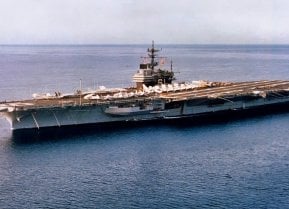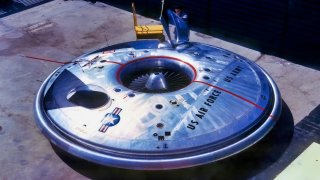VZ-9AV Avrocar: In 2007, the Air Force Museum Received a 'Flying Saucer'
The VZ-9AV Avrocar was the result of a Canadian effort to develop a supersonic, vertical takeoff and landing (VTOL) fighter-bomber in the early 1950s
Meet the VZ-9AV Avrocar: Is the alien spacecraft that crashed in Roswell, New Mexico, back in July 1947 now in the collection of the National Museum of the United States Air Force? It certainly could seem that way based on photos that the museum – located at Wright-Patterson Air Force Base (AFB), Dayton, Ohio – shared on Facebook last month.
A 'flying saucer' could be seen as it was unloaded from an Air Mobility Command C-5 Galaxy transport aircraft. It would appear to be proof that something is actually out there.
The mysterious aircraft wasn't actually from Roswell – rather it was from Canada, and it was built for the United States Air Force as part of Project 1794, an effort to develop a supersonic craft that could be used to shoot down Soviet bombers.
The flying saucer that was delivered to the museum was the Avro Canada VZ-9AV Avrocar.
"The Avrocar was the result of a Canadian effort to develop a supersonic, vertical takeoff and landing (VTOL) fighter-bomber in the early 1950s. However, its circular shape gave it the appearance of a 'flying saucer' out of science fiction movies of the period," the museum explained on its website, adding, "A.V. Roe (Avro) Aircraft Limited (later Avro Canada) based its design concept for the Avrocar on using the exhaust from turbojet engines to drive a circular 'turborotor' which produced thrust. By directing this thrust downward, the turborotor would create a cushion of air (also known as 'ground effect') upon which the aircraft would float at low altitude. When the thrust was directed toward the rear, the aircraft would accelerate and gain altitude."
VZ-9AV Avrocar: Truly a Flying Saucer
Rather than featuring the standard wing and fuselage design, it was literally a saucer-shaped vehicle. In theory, its designers believed it would have a top speed between Mach 3 and Mach 4, a ceiling of more than 100,000 feet, and a maximum range of 1,000 nautical miles.
The Canadian government, which had provided the initial funding, dropped the project when it became too expensive, but Avro then offered the design to the U.S. government – with the U.S. Army and U.S. Air Force showing interest.
However, each service had different requirements for the flying saucer-like aircraft.
The U.S. Army wanted to use it as a subsonic, all-terrain troop transport and reconnaissance craft, while the U.S. Air Force called for a vertical take-off and landing (VTOL) aircraft that could hover below enemy radar and then zoom up to supersonic speed. The VTOL capabilities would have negated the need for conventional runways and could theoretically be deployed almost anywhere. In addition, the completely circular design would have also embodied inherent stealth characteristics.
Even as those two sets of requirements greatly differed, the engineers at Avro initially believed they could satisfy both services.
"Research data originally indicated that a circular wing might satisfy both the Army's and Air Force's requirements, and Avro built two small test vehicles to prove the concept. Designated the VZ-9AV Avrocar ('VZ' stood for 'experimental vertical flight,' '9' for the ninth concept proposal, and 'AV' for Avro)," the museum added.
Unstable Platform
Science fiction may have suggested that a saucer was ideally suited to flight, but tests with models at Wright-Patterson AFB found that the cushion of air under the Avrocar would become unstable just a few feet off the ground. Moreover, the aircraft was simply incapable of reaching supersonic speeds.
Testing continued to determine if a suitable aircraft could still be developed for use by the Army. It was originally specified for a maximum speed of 300mph and a serviceable ceiling of 10,000 feet.
The initial prototype of the two built was even sent to the National Aeronautics and Space Administration (NASA) Ames Research Center at Moffett Field, Calif.
The subsequent wind tunnel tests proved that the aircraft had insufficient control for high-speed flight and was aerodynamically unstable. Despite the best efforts, the craft was never able to fly more than a few feet off the ground and never faster than 35mph. If it flew more than three feet above the ground, the Avrocar displayed uncontrollable pitch and roll motions, which the Avro engineers described as "hubcapping."
Rather than a high-flying saucer, the Army's Avrocar was little more than a slow-moving hovercraft. The project was canceled in December 1961 and the Canadian firm closed its doors a year later.
The first prototype – the aircraft seen in the photos shared on Facebook – arrived at the National Museum of the United States Air Force in 2007, and it is currently on display in the Research & Development Gallery. The second prototype is now in the collection of the United States Army Transportation Museum at Fort Eustis, Virginia.
Neither, of course, is a crashed UFO – but no doubt some might argue that is what the Pentagon simply wants us to believe. Wouldn't it be like the U.S. military to hide an alien flying saucer in plain sight?
Author Experience and Expertise
Peter Suciu is a Michigan-based writer. He has contributed to more than four dozen magazines, newspapers, and websites with over 3,200 published pieces over a twenty-year career in journalism. He regularly writes about military hardware, firearms history, cybersecurity, politics, and international affairs. Peter is also a Contributing Writer for Forbes and Clearance Jobs. You can follow him on Twitter: @PeterSuciu.


